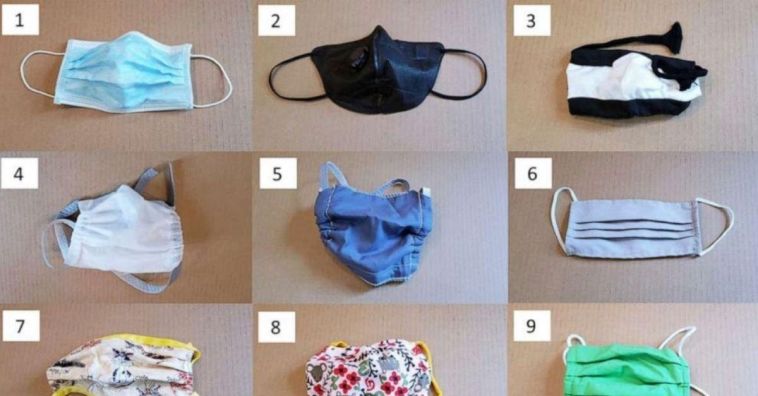With the Coronavirus still going strong and scientists trying to discover a solution to find a solution, people are taking precautions to avoid getting sick. Several of us have opted to stay home completely by social distancing, get our groceries delivered, and avoid the outside world to stop the spread of COVID-19. Others have braved the world and stepped outside, but with protection. Yes, I am talking about face masks. It’s funny to see how many people can get creative when it comes to wearing facemasks. Several researchers encourage people to wear the mask but want them to wear one that can actually work and protect them.
Videos By Rare
Health experts have officially counted 20 million cases of COVID-19 across the globe, which is why scientists from Duke University took a look at the face mask to see which one works best in order to slow down the spread of Coronavirus. In their study, scientists looked at 14 face masks including valved N95s, N-95s with valves, and several surgical masks to see how and if they were effective enough and how they were keeping droplets from getting out. To test the maks, scientists made use of a black box outfitted with a laser and a cell phone camera. Someone wearing a mask would speak in the direction of the laser beam inside the box. Then the number of respiratory droplets scattered by the beam was recorded by the camera in the back of the box. Then, computer algorithms counted the droplets seen in the video in order to determine how many had leaked through.
As over 20 million across the globe have been diagnosed with COVID-19, scientists from Duke University took a look at face masks to see which ones work best in slowing the spread of coronavirus. https://t.co/pu0dSP5ylJ
— Good Morning America (@GMA) August 11, 2020
According to Dr. Martin Fisher, who is an associate research professor from Duke University, “It was mainly focused on the technique, a simple technique to visualize these droplet emissions and the effects of masks.” The scientist did find out that not all maks are treated equally, but the experiment confirmed that most face covers do slow down the transmission of those droplets.
According to the new study, these are the top 6 most commonly used masks among the 14 masks that researchers tested.
Fitted N95 Masks
Duke University researchers found that the city N95 mask (N95 respirators), which has a sealed fit around your mouth h, protects those who wear it and others around them as well.
Surgical Masks
[buy_now link=amzn.to/33Q3uOg]
According to the study, several disposable surgical masks, non-woven, 3-layer, may seem flimsy but are actually engineered to catch all droplets. Doctors did state that if you want to be extra safe, you can add a face shield on top of the surgical masks, which is what several do when they aren’t getting with the high-risk COVID-19 case. That being said, a facial should not be used to replace a mask. This month, the CDC states that the blue surgical masks and the white N95 respirators are in critical supply due to the demand, and should be reserved for healthcare workers and other first responders. The Centers for Disease Control and Prevention also has guidance on its website on how to make your own mask at home to save some money and help stop the spread of the Coronavirus.
Cotton/ Polyester Mask
[buy_now link=”https://amzn.to/33OCy1e”]
Surprisingly enough, researchers found out that both polyester and cotton masks are unfortunately either a hit or miss. Which is surprising since most of us wear these on a regular basis. While we’re one can indeed protect you, several experts stated that more layers and generally better. Especially if they are a combination of several different materials in different layers such as polypro or cotton. What is really important here is how well it fits around our mouth and nose and make sure there are no big gaps in them.
Valved Masks
[buy_now link=amzn.to/33OR5df]
Just last week we saw how valved masks were banned from several airlines, which is not surprising. According to the study, researchers found out that valved masks do allow drops to escape through the valve. According to dr. Eric Westman, who’s an associate professor of medicine at Duke University, “It protects you, the wearer, but it doesn’t protect other people if by chance you have the disease and you don’t know We were very surprised to see how many particles came out of the valve.”
Bandanas
[buy_now link=amzn.to/2XTeiHt]
I can’t believe this even made the list, but here we are. Researchers found that using bandanas offers people very little protection. Let’s be real, we all saw this coming. Honestly, this isn’t news to anyone people, this isn’t covering anything underneath the surface. So yeah, stop wearing bandanas, it’s the least effective protection.
Neck Gaiters
[buy_now link=amzn.to/3iBn5FN]
Much like bananas, these very fashionable and popular face coverings among runners do not provide much protection. Gaiters, which are known for being made of fleece, were found to release several particles from the person wearing it and create more tiny droplets and speaking without a mask. According to Fisher, “This mask breaks down big droplets into you, multiple little droplets. These smaller droplets could be problematic because they have an easier time being carried away by air. So they might travel for the distance as opposed to just dropping down to the floor. So this was problematic.”
So, there you have it, your mask guide. An important thing to note here is that when picking out a mask make sure it fits snugly to make sure it stays on for the whole time. It’s tricky, but covering your mouth and nose, maybe under your chin, is your best bet. But you know what they say, any mask is better than no mask. So, use your judgment, just wear a mask, please.

